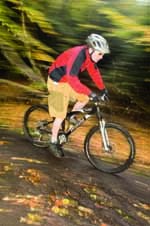 FRAME
FRAME
This year’s FSR XC frame look pretty similar to the ‘06 model but it now has an M4 aluminium front end instead of A1. Specialized claims that this upgrade makes the frame lighter and stiffer. A1 aluminium is still used for the rear end. Head tube, bottom bracket, seat tube and dropouts are all forged for strength and all five pivots of the FSR suspension system use cartridge bearings for low maintenance and reduced friction. Standard DU bushings, not the bearing system found on the more expensive Stumpjumpers, are used on the shock and they will wear out. A common problem with the interrupted seat tube design, other than exposing the shock to dirt, is that it offers very limited saddle height adjustment — not such a big deal for the experienced rider but it will mean that some newcomers will end up riding round obstacles rather than stopping, slamming the saddle down and having a go.
SUSPENSION
Just like the Fox units the X-Fusion O2RC shock is air sprung, oil damped and gets external rebound adjustment via the red dial. Instead of just having an on/off lock-out, or predetermined ProPedal damping, the X-Fusion shock has variable compression damping, so you can have everything from fully open and super active, to locked out, by simply moving the blue lever. RockShox’s Recon 335 fork has been reduced in travel from the stock 130mm to 100mm to match rear wheel travel. But it has also had the upper tubes cut down to save some weight. It’s easily the stiffest fork on test and goes just where you point it.
GROUPSET
The only thing that’s missing on the Specialized is a two-piece crank and external bottom bracket. Instead, the FSR gets a Shimano Octalink set-up, which is definitely a major upgrade over the square taper unit on the Cannondale, but nothing like as good as the Shimano LX crank fitted to the Trek. Juicy 3 disc brakes are Avid’s basic model but they sport many of the features found on the top-end units. Lever shape is excellent, power is second to none and we’d be happy to run the Juicy 3’s on considerably more expensive bikes. Attention to detail is taken one step further on the L and XL models, which come specced with bigger rotors front and rear. The idea being, that taller riders also tend to be heavier so therefore need extra stopping power.
COMPONENTS
If we’re really nit-picking the Specialized riser bar has a little too much backsweep for our tastes.
PERFORMANCE
Just as the name suggests, Specialized’s entry-level full-susser is designed for going fast. With this in mind less experienced riders may find the front end a tad low on steeper descents, even with the stem fully raised. Suspension performance is very well balanced front and rear and the X-Fusion shock and FSR rear end offer excellent traction. We also now know, from the miles put in on last year’s bike, that the shock is reliable. Cable routing isn’t the neatest and the brake hose bulges out and rubs on your leg when climbing in the saddle, as the bike squats a bit when ascending with the shock set to minimum compression damping. Both problems are easily cured by increasing the compression damping — which you can do while riding. You don’t need a trained eye to see that the FSR XC Comp is seriously well decked out. Avid Juicy 3 brakes are amazing and, with the 180mm rotor up front, you won’t struggle to get stopped.
VERDICT
Testing the FSR XC Comp second time round it’s easy to see why it won our budget bouncer test last year. It’s the lightest bike on test, the geometry is good, the spec is superb and it has impeccable trail manners, even if the front end is a bit head down for speed. But what really makes the Specialized FSR XC Comp a great bike is that it’s the most rounded package here. The only reason not to buy one is that you may find yourself stuck between the medium and large size.
MBR RATING: 9/10



